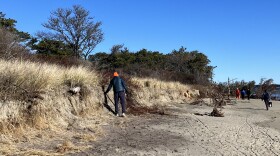Recent decades have brought a remarkable population bounceback for some of Connecticut's most charismatic birds of prey. But that same time span also brought new pressures to coastal-nesting communities of wading birds like night-herons and egrets.
That's according to the latest "State of the Birds" report from The Connecticut Audubon Society, which called specific attention to the strong recovery made by bald eagles, peregrine falcons and ospreys in Connecticut.
The Connecticut Audubon Society called the osprey “a truly remarkable conservation success story.” Ospreys, which currently number more than 800 nesting pairs in the state, are benefiting from some modern technology – using everything from billboards to cell towers to build nests.
Bald eagle nests can be found in 67 of the state’s 169 towns. The editor of this year’s report, Tom Andersen, called that a “significant and amazing achievement,” even though bald eagles are still listed as a state-threatened species.
Peregrine falcons are also considered a threatened species in the state, but their numbers are slowly growing. In the 1980s, the raptor couldn’t be found in Connecticut, but in 2022, 12 known active nesting territories were identified. Like ospreys, they can take advantage of man-made structures to build nests and rear their young.
But human behavior is negatively impacting coastal wading birds like herons and egrets, according to the Connecticut Audubon Society. The report says their populations have been decreasing since the 1980s.
More than a century ago, plumage from egrets was highly valued by hunters, leading to the extermination of many rookeries along the eastern seaboard. Conservationists intervened and populations began to recover, but as Connecticut’s suburbs grew, populations of racoons began to flourish, which was more bad news for wading bird nests on islands in Long Island Sound.
“They were wiped out on the Norwalk islands because raccoons were able to swim across and feast on the eggs,” Andersen said. “White-tailed deer swam across and ate the vegetation that the herons and egrets needed to nest.”
Today, coastal wading bird nesting colonies are restricted to five islands in Long Island Sound, according to The Connecticut Audubon Society.
Andersen also said wading birds don’t tolerate the presence of humans anywhere near their nests. So keeping undeveloped areas, particularly in Long Island Sound, wild is crucial.
He said there’s not much that can be done about the racoon and deer populations so we must do our best “to protect the remaining uninhabited islands in the Sound so that there are places for those birds to expand to when the population starts to grow again.”





